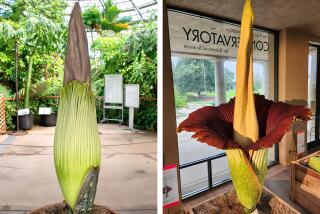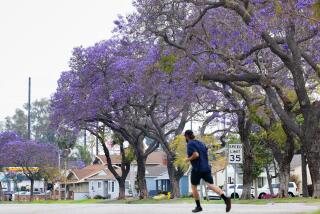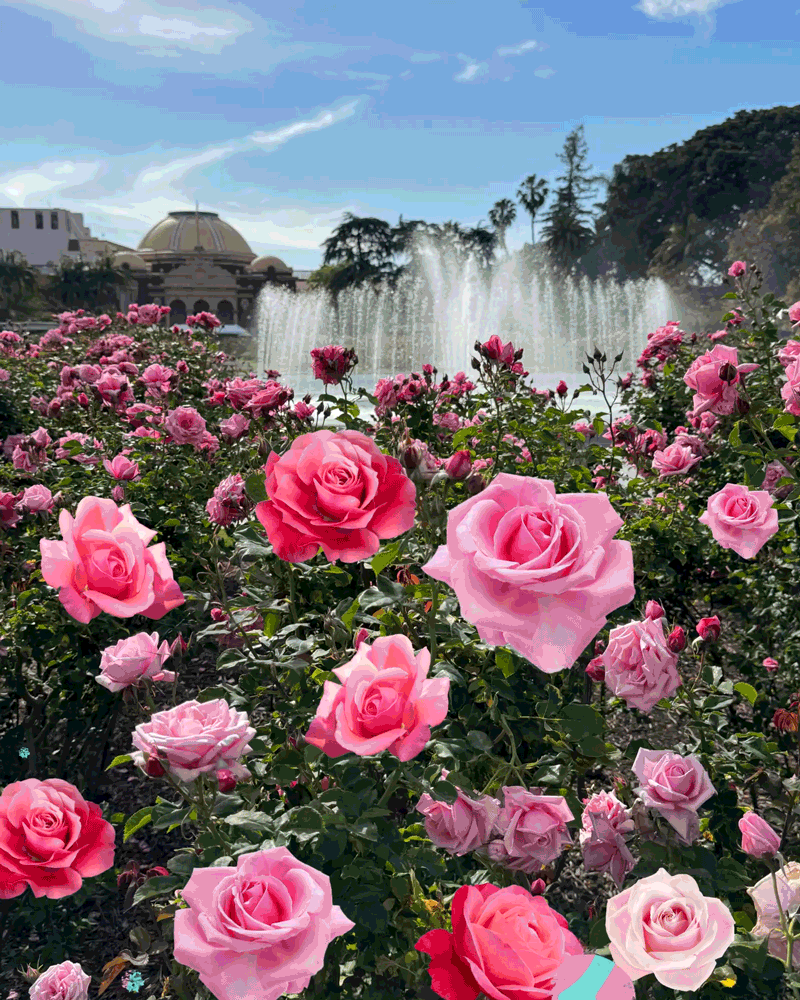Sweet Moment Arrives for a Foul Flower
What may be the world’s largest flower--and is certainly one of its foulest smelling--began its bloom Sunday night at the Huntington Gardens in San Marino for only the 11th time in North America.
The Amorphophallus titanum, a nearly 6-foot tall bud with a 3-foot wide crimson petal, emitted the distinctive odor of rotting meat as it sat in its ordinary plastic pot, trimmed with Spanish moss, in a very distinguished setting. The plant was displayed in the Greek-columned loggia of the Virginia Steele Scott Gallery of American Art--where it has already drawn thousands of excited botanical thrill seekers.
Normally found in the jungles of Sumatra, the plant, whose name means large, shapeless phallus, was brought to Europe in 1878 by an Italian botanist. The first flowering in cultivation occurred in Victorian England, where young women were said to have fainted from the stench.
Jim Comstock, a plant photographer at the Huntington on Sunday night, knew what they felt. The odor reminded him of the decaying carcass of an opossum that crawled under his house and behind a wall to die. “It took a week and a half to find a guy who would get it out,” he said.
The plant first flowered in the United States in 1937 at the New York Botanical Gardens and was later reportedly named the official flower of the Bronx. That had nothing to do with its smell. It had to do with the rapid growth of the borough and the flower, which adds 4 inches a day to its stature before blooming.
The Huntington’s flowering is the first in California.
Technically not one flower but a cluster of hundreds of small flowers at the base of a column that resembles a gargantuan Japanese eggplant, the plant is expected to hold its bloom for only two days.
But Huntington plant curator John Trager was standing by with a bag of rotting apples, hoping for an opportunity to propagate the plant when its petal fully opens. Trager’s plan: to substitute himself for the Indonesian beetles that would normally feed off the plant and, in so doing, pick up pollen from its male flowers and rub it on the female flowers of another plant of the same species.
Trager plans to take pollen from male flowers, put it in the bag with the apples and hope the ethylene gas released from the fruit hastens the pollen’s maturation. Then he plans to rub some on female flowers and hope the marriage produces seeds.
This, he explained, is standard procedure for an endangered plant.
Lisa Blackburn, a spokeswoman for the Huntington, said a near record crowd of 7,100 came Sunday “mainly to see this.”
“It was surrounded all day by plant lovers who were watching it carefully because they knew it was about to bloom,” she said.
How did they know?
Besides regular updates on the Huntington’s Web site, Blackburn, outfitted in an Amorphophallus titanum T-shirt, observed: “The flies were gathering. The odor was starting to waft.”
Because of the special event, the Huntington--normally closed Mondays--will be open today from 10:30 a.m. to 4:30 p.m.






